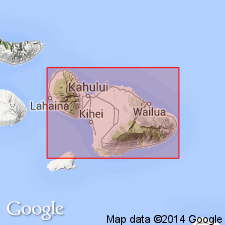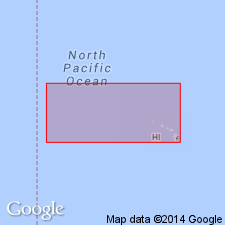
- Usage in publication:
-
- Keanae basalt*
- Modifications:
-
- Named
- Dominant lithology:
-
- Basalt
- AAPG geologic province:
-
- Maui
Summary:
[Named for] village of Keanae, N coast of Island of Maui. At 1300 ft covers entire floor of Keanae Valley, but farther N it divides into 2 branches, one followed E wall of valley and the other the gulch of Piinaau Stream. At coast forms lava delta on which village of Keanae is located. Included as unit of Hana volcanic series. Composed of dark gray olivine basalt with phenocrysts of olivine and augite. Underlies sedimentary rocks of Pleistocene and Recent age; overlies Waiokamilo basalt (new), Piinaau basalt, Ohia basalt (new) (all of Hana volcanic series) and unconformably overlies Honomanu volcanic series (new). Map shows middle(?) and late Pleistocene and Recent age.
Source: GNU records (USGS DDS-6; Menlo GNULEX).

- Usage in publication:
-
- Keanae basalt*
- Modifications:
-
- Age modified
- AAPG geologic province:
-
- Maui
Summary:
Type locality: Keanae village, near mouth of Keanae Valley [20 deg 51' 41"N, 156 deg 09' 06"W, Keanae 7.5' quad] north part of Island of Maui, HI. Unconformably overlies Pauwalu, Piinaau, and Ohia Basalts and older alluvium. Assigned Pleistocene(?) age.
Source: GNU records (USGS DDS-6; Menlo GNULEX).

- Usage in publication:
-
- Keanae Basalt†
- Modifications:
-
- Abandoned
- AAPG geologic province:
-
- Maui
Summary:
Keanae Basalt of Stearns and Macdonald (1942) abandoned as formally named unit and called Keanae flow, informal unit of Hana Volcanics. Hana Volcanics assigned Pleistocene(?) and Holocene age.
Source: GNU records (USGS DDS-6; Menlo GNULEX).
- Usage in publication:
-
- Keanae flow
- Modifications:
-
- Age modified
Sherrod, D.R., Hagstrum, J.T., McGeehin, J.P., Champion, D.E., and Trusdell, F.A., 2006, Distribution, 14C chronology, and paleomagnetism of latest Pleistocene and Holocene lava flows at Haleakalā volcano, Island of Maui, Hawaii; A revision of lava flow hazard zones: Journal of Geophysical Research, B, Solid Earth, v. 111, no. B05205, 24 p.
Summary:
For more information, please contact Nancy Stamm, Geologic Names Committee Secretary.
Asterisk (*) indicates published by U.S. Geological Survey authors.
"No current usage" (†) implies that a name has been abandoned or has fallen into disuse. Former usage and, if known, replacement name given in parentheses ( ).
Slash (/) indicates name conflicts with nomenclatural guidelines (CSN, 1933; ACSN, 1961, 1970; NACSN, 1983, 2005, 2021). May be explained within brackets ([ ]).

